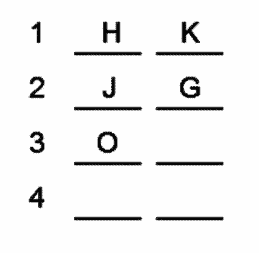Game Setup
This is a type of linear game, but it has elements in common with grouping. We’re not just concerned with how the variables are ordered. We’re also concerned with which variables can go with each other. There are four different weeks and each has two variables. I find it easiest to arrange vertically like this:

There are eight spots but only seven variables, so one, and exactly one, of the variables will repeat. When considering the rules, think about who can repeat.
For example, J can’t repeat. The first rule says that when J is advertised then H is advertised right before. That means that if you had two Js then you would need two Hs.
So J can’t repeat. We will come back to this rule later. I didn’t find it useful to draw the rule separately. Instead I use it to make a deduction on our main diagram.
The second rule is one you should simply commit to memory. The product advertised in two weeks has to be in week 4 and cannot be in week 3. If you want, you can write a mark next to your diagram that says “not 2” beside 3 and “2” beside 4 or something to that effect.
There is no single set format that is going to be correct for this unique style of rule.
Instead, it’s just something you need to be aware of. However you remember it, you will be much more effective on this type of game if you keep it in your mind.
The third rule is interesting. If you have G then you need J or O in the same space.

Lastly, O goes in week 3.
Let’s go back to the rule where J has H right before it. Where we can put J? We can’t put J in spot 1 because there is no space to put H before it.

Now what about spot 3 with O? Here is what it would look like:

We can see that O and J are together and that H is in spot 2. O and J can’t repeat, since they are in spot 3. The third rule says that G needs to go with J or O; G has nobody to go with. This doesn’t work either.
We can try J in spot 4. Here’s what that would look like:

We have J and G together because G goes with J or O. H is in spot 3 because H goes before J. This looks ok…except that the person who repeats has to be in the fourth row.
Who can we repeat? If we repeat J then we have to repeat H, so that doesn’t work. If we repeat G then we have to repeat one of O or J as well. (G has to go with O or J). So this doesn’t work either.
It turns out that the only place J can go is in spot 2. It’s a very important deduction and here is what it looks like:

J is always in 2. H is always in 1 because it goes before J. O is always in 3. K goes in 1 or 2.
J, O, and G can’t repeat. H and K could repeat. K has to go in 1 or 2, but it could go elsewhere too. Likewise, there’s nothing to stop H from going in spot 4 as well as spot 1.
If you can split a game into two separate scenarios then you should always try and see what happens. Look for something that can only be one of either two ways and see what happens in both situations.
In this case, G can only go with J or O. We know that J is in 2 and O is in 3. So it’s worthwhile to find out what happens when G goes in either of those spots.
Let’s try putting G in spot 2. We know that K has to be in either spot 1 or 2. So if J and G are in 2 then K must go in spot 1. Here is what it looks like:

We have to fill the fourth row and the empty space in the third row. We have L and M left and K and H are repeatable. We’ve already satisfied all of the rules for K and H, so either could go in 4 as well. L and M can’t be the repeated variables here. They only have space to go in 3 and 4, and variables in 3 can’t repeat.
Here is what the complete diagram looks like, when G goes with J:

Now we should see what happens if we put G in 3 with O instead. This one is a bit more open ended. In fact, nothing much happens at all.

We now have H in 1, J in 2, O and G in 3. We must put K somewhere in the first two rows. That means we’ll have to have one of L and M in the last row and the other L and M is going to go in the first row.
The repeated variable could be: H, K or the L/M that was in the first row. It’s very open ended. Just know that when O and G are together in 3, a lot more can happen.
Notice that I’ve drawn most rules directly on the diagram. That’s how I prefer to do things. It’s a lot easier to remember the rules if they’re drawn right in front of me. It also prevents me from forgetting deductions. The greatest problem I see on logic games is that people will make a good deduction then forget it 20 seconds later.


Leave a Reply